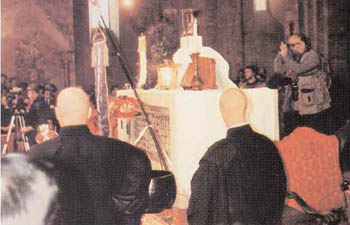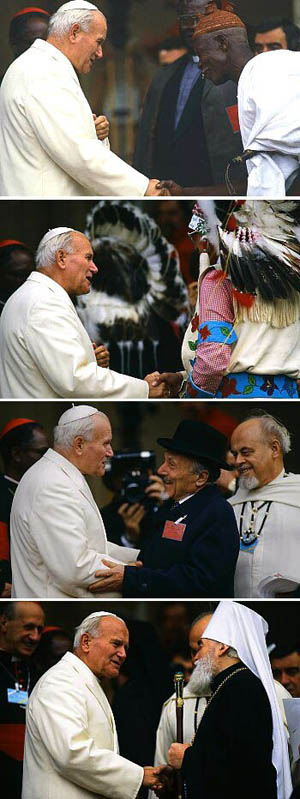 |
Church - State Relations
JPII & Dignitatis Humanae - II
The Contours of Liberty of Conscience according to John Paul II
Julio Alvear, Ph.D.
The principal content of Dignitatis humanae (DH), according to John Paul II, is this: According to the Council, the Church must promote a strict natural right to religious liberty, which must have a universal character and be founded on the dignity of the human person. This right must be recognized by positive laws in the national, supra-national and international spheres for every individual, group or community. The basic object of this religious liberty is, in its negative character, immunity from any coercion.

Assisi 1986 - To not offend the infidel, JPII forbids the statue of Our Lady of Fatima to enter the Basilica, but allows a statue of Buddha over a Tabernacle... |
It is in the name of the human dignity that the conscience should be respected. In this context, “liberty of conscience” is defined as “the basic right of the person neither to be forced to act against his own conscience nor to be prevented from acting according to it.” (1) Conscience, however, is not absolutely autonomous, (2) because it has the moral obligation to be in accordance with the Law of God. It must be “upright” and true. (3)
However, even if it is not - for example in the case of an erroneous conscience whose ignorance can be overcome - the person cannot juridically be the object of any coercion in religious matters, according to John Paul II. This is because “every person has the right to seek religious truth and to fully adhere to it in full liberty, immune from any coercion on the part of individuals, social groups or any human power whatsoever, in such a way that in religious matters no one should be forced to act - within the just limits - according to his own conscience nor prevented from acting according to his conscience, whether alone or in association with others’ (DH 2-1).” (4)
An interpretation that follows the previous Magisterium
For John Paul II, the negative content of religious liberty - immunity from any coercion - is the essential aspect of liberty of conscience that allows him to establish a bridge with traditional Catholic doctrine, based on the moral obligation that every man has to seek the truth - which is found in the Church - and embrace it. If the religious liberty consecrated by DH is not a positive right but only a negative right, no one can accuse the Council of recognizing this bias as a right to “liberty of perdition,” ignoring that the Catholic Church is the Church founded by Our Lord Jesus Christ for the salvation of all men.
From this perspective, then, DH would be in full continuity with the traditional papal Magisterium: “Those who believe in the true God, out of respect for the Truth they profess in full faith, cannot admit the equivalence of all the religious faiths, let alone fall into religious indifference. They want all men to comply with the truth they know, and they facilitate this by a testimony that respects freedom of membership, because it befits the dignity of man to open himself to religious faith by a free homage of the reason and the heart, aided by grace, in accordance with what he discovers and the well-formed conscience prescribes.” (5)
When the problem starts…
Is this, though, the last word of John Paul II’s teaching on the matter of religious liberty? Some persons audaciously affirm it to be so. (6) As we delve deeper into his teachings, however, numerous of his statements present the right to the religious liberty as having a clearly broader foundation than the one suggested by some on his interpreters.

Assisi 1986 - JPII encouraging false religions: from top, animist, idolaters, Jews & Schismatics |
The Pontiff pushes us, whether we like it or not, to a post-conciliar hermeneutic of DH with much more controversial contours. Immunity from all coercion is an integral – but not complete – part of the specific object of the right of religious liberty, which now appears with a much more demanding aspect.
Indeed, the transition from the negative to the positive content of the right of religious liberty can be included in the very notion of immunity from coercion. Coercion, compulsion, intimidation… are similar terms used or presupposed in DH to reject all types of exterior pressure, either physical or moral. But these words have variable extensions. They can signify simply prohibiting violations of the inner conscience or forcing an act of faith, which is in perfect continuity with what the Church has always taught.
But they can also be understood, by way of development, as the obligation to forbid the preeminence of one religious value over another in public life. Based on this, some persons consider that displaying the Crucifix in public places constitutes a type of moral pressure exerted on non-Christians. In any case, this can support a stand, based on principles and doctrinal demands, that advocates equal treatment of all religions in the public realm.
This is the position that appears to have been adopted by John Paul II, judging from his words. In effect, in the same paragraph of the speech previously quoted, he affirms that if, subjectively, “those who believe in the true God, out of respect for the Truth they profess in full faith, cannot admit the equivalence of all religious faiths, let alone fall into religious indifference,” at the same time they “can and must respect the dignity of other persons, who should not be prevented from acting according to their conscience, above all in religious matters,” This is because “the domain of religious liberty must also involve reciprocity, that is, equal treatment.” From such a perspective, the contours between the negative and the positive content of religious liberty become blurred.
Here we must definitively move one step forward. John Paul II goes much further than imagined by some of his interpreters, who presume their wishful thinking to be the reality.
1. Allocution Nel darvi cordialmente to the members of the Catholic Italian Association of Physicians, December 28, 1978..
2. Fides et ratio, encyclical on the relations between faith and reason, September 14, 1994, n. 98.
3. On the upright and true conscience, see the Encyclical Veritatis splendor on some basic questions of the moral teaching of the Church, August 6. 1993, nn. 54-57, 59, 61-64 (the last text includes a quote from DH 14) and the message I molti popoli to the 24th World Journey of Peace of January 1, 1991, December 8, 1990, 1-3.
On moral conscience and its obligation to be in conformance with Eternal Law, see the Allocution Le parole dell’Apostolo, general audience of August 17, 1983, with n.2 quoting DH 3 and n. 3 quoting DH 14 as well as Gaudium et spes 16 (nn 1, 3).
On the erroneous judgment of the conscience, see The Catechism of the Catholic Church, nn. 1790-1794.
4. Apostolic exhortation Catechesi tradendae of October 16, 1979, n. 14. The Catechism of the Catholic Church eloquently defines this aspect of religious liberty in numbers 2104-2106, 2108-2109. It is even more liberally defined in his speech Questo incontro on religious liberty at the 5th International Congress of Juridical Studies, March 10, 1984, nn. 5-6, as well as in the Encyclical Veritatis splendor, n. 31, which applies DH 1.
5. Speech of John Paul II to the members of the Diplomatic Corps accredited by the Holy See, January 12, 1985, n. 3.
6. See for example Maria Fernanda Balmaseda, “La liberdad de consciencia en Juan Pablo Magno. Tras las huellas de Santo Tomás,” in Studium, Madrid, vol. 48-3, 2008, pp. 497-506.
Continued

Article first published in the magazine Catholica, Paris, Spring 2009
Posted October 31, 2012

Related Topics of Interest
 JPII's Hermeneutic Criteria for Dignitatis Humanae JPII's Hermeneutic Criteria for Dignitatis Humanae
 A Statue of Buddha over the Tabernacle in Assisi A Statue of Buddha over the Tabernacle in Assisi
 Hindu-Catholic Syncretism in Bangladesh Hindu-Catholic Syncretism in Bangladesh
 JPII Pays Homage to a Buddhist High Priest JPII Pays Homage to a Buddhist High Priest
 JPII Offers Homage at Gandhi's Tomb JPII Offers Homage at Gandhi's Tomb
 John Paul II Praises Buddhist ‘Wisdom’ John Paul II Praises Buddhist ‘Wisdom’
 John Paul II Greets an African Voodoo 'Priest' John Paul II Greets an African Voodoo 'Priest'
 A Rabbi Lectures JPII A Rabbi Lectures JPII
 John Paul II Blessed by 160 Rabbis John Paul II Blessed by 160 Rabbis

Related Works of Interest
|
|
Church-State | Cultural |
Home | Books | CDs
| Search | Contact Us
| Donate

© 2002- Tradition in Action, Inc. All Rights Reserved
|
 |

|